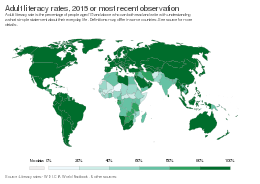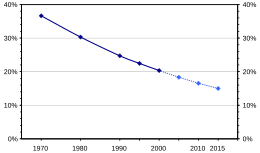
A | B | C | D | E | F | G | H | CH | I | J | K | L | M | N | O | P | Q | R | S | T | U | V | W | X | Y | Z | 0 | 1 | 2 | 3 | 4 | 5 | 6 | 7 | 8 | 9
This article may be too long to read and navigate comfortably. When this tag was added, its readable prose size was 14,000 words. (April 2023) |
| Part of a series on |
| Reading |
|---|
 |
Literacy is the ability to read and write. Broadly, literacy may be viewed as "particular ways of thinking about and doing reading and writing"[1] with the purpose of understanding or expressing thoughts or ideas in written form in some specific context of use.[2] In other words, humans in literate societies have sets of practices for producing and consuming writing, and they also have beliefs about these practices.[3] Reading, in this view, is always reading something for some purpose; writing is always writing something for someone for some purpose.[4] Beliefs about reading and writing and their value for society and for the individual always influence the ways literacy is taught, learned, and practiced.[5]
Some researchers suggest that the study of "literacy" as a concept can be divided into two periods: the period before 1950, when literacy was understood solely as alphabetical literacy (word and letter recognition); and the period after 1950, when literacy slowly began to be considered as a wider concept and process, including the social and cultural aspects of reading and writing[6] and functional literacy.[7][8]

Definition



The range of definitions of literacy used by NGOs, think tanks, and advocacy groups since the 1990s suggests that this shift in understanding from "discrete skill" to "social practice" is both ongoing and uneven. Some definitions remain fairly closely aligned with the traditional "ability to read and write" connotation, whereas others take a broader view:
- The 2003 National Assessment of Adult Literacy (USA) included "quantitative literacy" (numeracy) in its treatment of literacy. It defined literacy as "the ability to use printed and written information to function in society, to achieve one's goals, and to develop one's knowledge and potential."[10] It included three types of adult literacy: prose (e.g., a newspaper article), documents (e.g., a bus schedule), and quantitative literacy (e.g., the use of arithmetic operations in a product advertisement).[11][12]
- In 2015, the United Nations Statistics Division defined the youth literacy rate as "the percentage of the population aged 15–24 years who can both read and write with understanding a short simple statement on everyday life."[13]
- In 2016, the European Literacy Policy Network defined literacy as "the ability to read and write in all media (print or electronic), including digital literacy."[14]
- In 2018, UNESCO included "printed and written materials" and "varying contexts" in its definition of literacy, i.e., "the ability to identify, understand, interpret, create, communicate and compute, using printed and written materials associated with varying contexts."[15]
- In 2019, the Organisation for Economic Co-operation and Development (OECD), in its PIAAC adult skills surveys, included "written texts" in its definition of literacy, i.e., "the ability to understand, evaluate, use and engage with written texts in order to participate in society, achieve one's goals, and develop one's knowledge and potential."[16][17] Also, it treats numeracy and problem solving using technology as separate considerations.[18]
- In 2021, Education Scotland and the National Literacy Trust in the UK included oral communication skills (listening and speaking) under the umbrella of literacy.[19][20]
- As of 2021, the International Literacy Association uses "the ability to identify, understand, interpret, create, compute, and communicate using visual, audible, and digital materials across disciplines and in any context."[21][22]
- The expression "reading literacy" is used by the Progress in International Reading Literacy Study (PIRLS), which has monitored international trends in reading achievement at the fourth grade level since 2001.[23]
- Other organizations might include numeracy skills and technology skills separately but alongside literacy skills;[24] still others emphasize the increasing involvement of computers and other digital technologies in communication that necessitates additional skills (e.g., interfacing with web browsers and word processing programs, organizing and altering the configuration of files, etc.).[25]
The concept of multiliteracies has gained currency, particularly in English Language Arts curricula, on the grounds that reading "is interactive and informative, and occurs in ever-increasingly technological settings where information is part of spatial, audio, and visual patterns (Rhodes & Robnolt, 2009)".[26][27][verification needed] Objections have been raised that this concept downplays the importance of reading instruction that focuses on "alphabetic representations".[28] However, these are not mutually exclusive, as children can become proficient in word-reading while engaging with multiliteracies.[29]
Word reading is fundamental for multiple forms of communication.[29] Beginning in the 1940s, the term literacy has often been used to mean having knowledge or skill in a particular field, such as:
- Computer literacy – Skill in using computers and digital technology[30][31]
- Statistical literacy – Ability to understand and reason with statistics and data[32]
- Critical literacy – Ability to find embedded discrimination in media[33]
- Media literacy – Ability to navigate various types of media and see their claims in a broader context[34]
- Ecological literacy – Ability to understand natural systems and their interactions[35]
- Disaster literacy – Proposed model for the ability to understand and use life-saving information, including the ability to respond and recover from disasters effectively[36][37]
- Health literacy – Ability to understand healthcare information[38][39][40]
- Linguistic literacy – Ability to read, write, understand, and speak any type of language[41]
- Social literacy – Literacy gained through social interactions[42]
- Quantitative literacy aka numeracy – Ability to apply numerical concepts[12] Zdroj:https://en.wikipedia.org?pojem=Illiterate
Text je dostupný za podmienok Creative Commons Attribution/Share-Alike License 3.0 Unported; prípadne za ďalších podmienok. Podrobnejšie informácie nájdete na stránke Podmienky použitia.
Antropológia
Aplikované vedy
Bibliometria
Dejiny vedy
Encyklopédie
Filozofia vedy
Forenzné vedy
Humanitné vedy
Knižničná veda
Kryogenika
Kryptológia
Kulturológia
Literárna veda
Medzidisciplinárne oblasti
Metódy kvantitatívnej analýzy
Metavedy
Metodika
Text je dostupný za podmienok Creative
Commons Attribution/Share-Alike License 3.0 Unported; prípadne za ďalších
podmienok.
Podrobnejšie informácie nájdete na stránke Podmienky
použitia.
www.astronomia.sk | www.biologia.sk | www.botanika.sk | www.dejiny.sk | www.economy.sk | www.elektrotechnika.sk | www.estetika.sk | www.farmakologia.sk | www.filozofia.sk | Fyzika | www.futurologia.sk | www.genetika.sk | www.chemia.sk | www.lingvistika.sk | www.politologia.sk | www.psychologia.sk | www.sexuologia.sk | www.sociologia.sk | www.veda.sk I www.zoologia.sk
